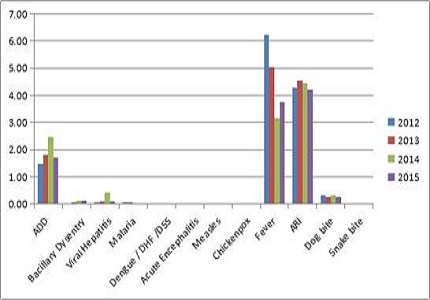A comprehensive study of disease pattern in world’s largest mass gathering
Abstract
Introduction: A Comprehensive Study of disease pattern in mass gathering of Simhasth Fair in Ujjain city was conducted. Objective of the study were to know the disease trends in a huge event, to know the risk factor triggered by the surveillance system, to assess the importance of health planning and monitoring in a mass gathering and to provide a pathway to future endowers. To provide complete physical, mental and social well being of the pilgrims, state health department established all necessary arrangements.
Methods: The period of the data collection of the study was 21 April to 22 May 2016. A stipulated proforma was designed for daily reporting. It was insured that all outbreaks must reported immediately. Analysis and forecasting of the data would be done simultaneously. The data collected on the daily basis. Data were compiled and validated every day.
Results: A total of 3,21.841 patients were screened in OPD and 19178 patients were treated as IPD. Highest number of cases recorded of fever i.e. 18,700 (6.95%), followed by acute respiratory infection (ARI), 15,834 (5.89%), Acute diarrheal disease (ADD) 14,715 (5.47%), skin disease 3089 (1.15), heat stroke 1225 (0.46%) and rest shared by injuries 1143 (0.42%), conjunctivitis 823 (0.31%), bacillary dysentery 320 (0.12%), malaria 62 (0.02%), Jaundice/Viral hepatitis 58 (0.02%), chicken pox 21 (0.01%). The cases of dog bite were 504 (0.19%), snake bite 6 (0.01%), Burn 84 (0.03%) and drowning 18 (0.01%). A better planning and forecasting system can provide a solid background to reduce the disease in large gathering.
Downloads
References
2. Memish ZA, Zumla A, Alhakeem RF, Assiri A, Turkestani A, Al Harby KD, Alyemni M, Dhafar K, Gautret P, Barbeschi M, McCloskey B, Heymann D, Al Rabeeah AA, Al-Tawfiq JA. Hajj: infectious disease surveillance and control. Lancet. 2014 Jun 14;383(9934): 2073-82. doi: 10.1016/S0140-6736 (14)60381-0. Epub 2014 May 20.
3. Khan K, Sears J, Wei Hu V, Brownstein JS, Hay S, Kossowsky D, et al. Potential for the international spread of middle east respiratory syndrome in association with mass gatherings in Saudi Arabia. PLoS Curr Outbreaks 2013. edition 1.
4. Olympic Planning Unit National School of Public Health Greece. Mass gathering and public health: The experience of Athens 2004 Olympic games. Available at: http://www.euro.who.int/__data/assets/pdf_file/0009/98415/E90712.pdf (online monograph).
5. Pellerin J, Edmond MB. Infections associated with religious rituals. Int J Infect Dis. 2013 Nov;17(11):e945-8. doi: 10.1016/j.ijid.2013.05.001. Epub 2013 Jun 18.
6. The Kumbh Mela Public Health (KMPH) team (HSPH). Public health at the Kumbh Mela. Available at: http:// fxbkumbh. wordpress.com/. [Last accessed 07.10.14] (online monograph).
7. De Lorenzo RA. Mass gathering medicine: a review. Prehosp Disaster Med. 1997 Jan-Mar;12(1):68-72.
8. Baker WM et. al. Special event medical care: the 1984 Los Angeles summer Olympic experience. Annals of Emergency Medicine, 1986, 15:185-190.
9. Franaszek J. Medical care at mass gatherings. Ann Emerg Med. 1986 May;15(5):600-1. [PubMed]
10. United States Centers for Disease Control and Prevention. Serogroup W-135 meningococcal disease among travelers returning from Saudi Arabia-United States, 2000, MMWR Morbidity and Mortality Weekly Report 2000, 46:345-346.
11. Ehresmann KR, Hedberg CW, Grimm MB, Norton CA, MacDonald KL, Osterholm MT. An outbreak of measles at an international sporting event with airborne transmission in a domed stadium. J Infect Dis. 1995 Mar;171(3):679-83.
12. Global infectious disease surveillance, Genava, World Health Organization, 1998 (Fact Sheet No. 200)
13. Rowbotham TJ. Legionellosis associated with ships: 1977 to 1997. Commun Dis Public Health. 1998 Sep;1 (3): 146-51. [PubMed]
14. Mass Gathering Event Management - A Case Study of MahaKumbh, 2013, Allahabad, Bihar State Disaster Management Authority, 2013.
15. Ayyagari A, Bhargava A, Agarwal R, Mishra SK, Mishra AK, Das SR, Shah R, Singh SK, Pandey A. Use of telemedicine in evading cholera outbreak in Mahakumbh Mela, Prayag, UP, India: an encouraging experience. Telemed J E Health. 2003 Spring;9(1):89-94.
16. Pradhan S (Reuters). Allahabad stampede kills 36 Kumbh Mela pilgrims. Available online: http://in.reuters.com/article/2013/02/11/ kumbh- melastampede- allahabad- update-idINDEE 91907I 20130211. (online monograph).

Copyright (c) 2017 Author (s). Published by Siddharth Health Research and Social Welfare Society

This work is licensed under a Creative Commons Attribution 4.0 International License.


 OAI - Open Archives Initiative
OAI - Open Archives Initiative


